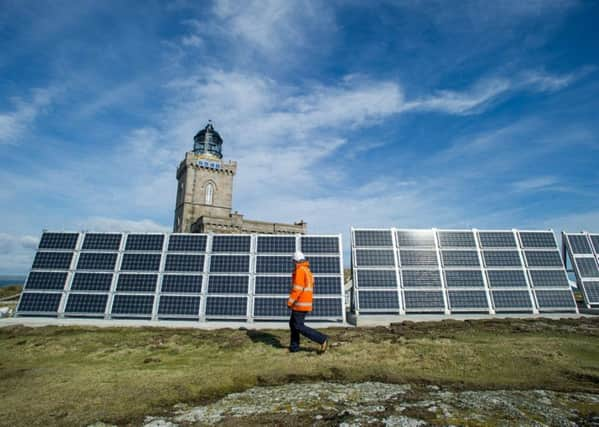Scotland's lighthouses a shining beacon of solar technology


Scotland’s lighthouses are deploying the latest solar power technology to help guide mariners through the harshest of environments with running costs radically cut by the switch to renewable energy.
Solar power has been used by the Northern Lighthouse Board for several years but the short days in Scotland’s far north have long posed a problem for engineers seeking to generate and store enough energy to keep lamps and buoys alight over the winter months.
Advertisement
Hide AdAdvertisement
Hide AdNow improvements to photovoltaic (PV) technology, battery storage and low-energy lamps mean that the NLB is potentially saving £30,000 a year running and maintaining the hardest to reach lighthouses which have traditionally been powered by diesel engines.
Lighthouses are set to further benefit from improvements to electric car technology given the sector’s vital research in how vast amounts of energy can be stored over greater periods of time.
Mike Bullock , chief executive of Northern Lighthouse Board, said: “We have an area of responsibility that reaches from the south of the Isle of Man to Muckle Flugga in the far North of Shetland. We’re obviously dealing with locations that have extremely short periods of daylight during winter months.
“Nevertheless the solar technology we deploy is now able to overcome this. We’re determined to pursue a policy of using renewable energy wherever we can.
“Converting the lights to solar energy will make a significant saving in maintenance and operating costs, through greater reliability and lower power requirements as well as reducing our carbon footprint.”
This summer, NLB will fit a 70 watt solar panel to a floating buoy for the first time with the equipment generating more than three times the energy produced by earlier models – at a fraction of the price
The increase in power supplied to the buoy, which sits in the Moray Firth near Lossiemouth, will allow useful navigational aids to be incorporated into its function.
These include Automatic Identification System (AIS), which can track and monitor vessel movements, and Racons, or radar beacons, which are mainly used to mark isolated or significant hazards.
Advertisement
Hide AdAdvertisement
Hide AdThe Racons are of particular use on the east coast of Scotland, which has limited radar features.
Meanwhile, developments in PV systems means that lighthouses in even the most inhospitable locations can now be fully operated by solar power.
These include the Isle of May in the Firth of Forth, which was designed by Robert Stevenson in 1816.
It is one of the latest NLB lighthouses to have its power supply changed from diesel engines to solar charging.
A bank of 54 solar panels has been installed to the south of the lighthouse to maximise solar gain.
Solar energy is used to charge powerful batteries which then power the light, with the large capacity of the batteries allowing sufficient energy to build up in the summer and autumn to ensure the light operates throughout the winter months.
Storage space for the batteries can, however, prove problematic with new nickel metal halide batteries brought in to improve capacity of the cells.
NLB said it would benefit from the work being carried out on electric car technology which is bringing down the cost of lithium ion and other rare earth technologies which currently aren’t mainstream.
Advertisement
Hide AdAdvertisement
Hide AdThere are now 128 NLB lighthouses that rely solely on solar power with a further 12 using an engine as back-up.
NLB operates and maintains 206 lighthouses and 167 buoys in Scotland and the Isle of Man. The lights are switched on automatically using daylight sensors and monitored from Edinburgh 24 hours a day.